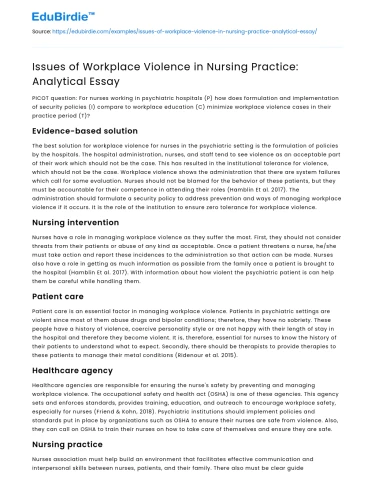PICOT question: For nurses working in psychiatric hospitals (P) how does formulation and implementation of security policies (I) compare to workplace education (C) minimize workplace violence cases in their practice period (T)?
Evidence-based solution
The best solution for workplace violence for nurses in the psychiatric setting is the formulation of policies by the hospitals. The hospital administration, nurses, and staff tend to see violence as an acceptable part of their work which should not be the case. This has resulted in the institutional tolerance for violence, which should not be the case. Workplace violence shows the administration that there are system failures which call for some evaluation. Nurses should not be blamed for the behavior of these patients, but they must be accountable for their competence in attending their roles (Hamblin Et al. 2017). The administration should formulate a security policy to address prevention and ways of managing workplace violence if it occurs. It is the role of the institution to ensure zero tolerance for workplace violence.
Save your time!
We can take care of your essay
- Proper editing and formatting
- Free revision, title page, and bibliography
- Flexible prices and money-back guarantee
Nursing intervention
Nurses have a role in managing workplace violence as they suffer the most. First, they should not consider threats from their patients or abuse of any kind as acceptable. Once a patient threatens a nurse, he/she must take action and report these incidences to the administration so that action can be made. Nurses also have a role in getting as much information as possible from the family once a patient is brought to the hospital (Hamblin Et al. 2017). With information about how violent the psychiatric patient is can help them be careful while handling them.
Patient care
Patient care is an essential factor in managing workplace violence. Patients in psychiatric settings are violent since most of them abuse drugs and bipolar conditions; therefore, they have no sobriety. These people have a history of violence, coercive personality style or are not happy with their length of stay in the hospital and therefore they become violent. It is, therefore, essential for nurses to know the history of their patients to understand what to expect. Secondly, there should be therapists to provide therapies to these patients to manage their metal conditions (Ridenour et al. 2015).
Healthcare agency
Healthcare agencies are responsible for ensuring the nurse's safety by preventing and managing workplace violence. The occupational safety and health act (OSHA) is one of these agencies. This agency sets and enforces standards, provides training, education, and outreach to encourage workplace safety, especially for nurses (Friend & Kohn, 2018). Psychiatric institutions should implement policies and standards put in place by organizations such as OSHA to ensure their nurses are safe from violence. Also, they can call on OSHA to train their nurses on how to take care of themselves and ensure they are safe.
Nursing practice
Nurses association must help build an environment that facilitates effective communication and interpersonal skills between nurses, patients, and their family. There also must be clear guidelines regarding supervisors responsible for workplace behavior regarding documentation, reporting, and actual patients engaging in workplace violence (Lantta et al. 2016). Nurses must be informed about the guidelines when they are being oriented and during the yearly review. All nurses must work collaboratively to support any nurse being victimized or abused by the patients. Finally, there must be security measures put in place to secure nurses from the abusers who may cause harm to them. This can be enabled through having security officers and CCTVs in patient’s wards.
References
- Ridenour, M., Lanza, M., Hendricks, S., Hartley, D., Rierdan, J., Zeiss, R., & Amandus, H. (2015). Incidence and risk factors of workplace violence on psychiatric staff. Work, 51(1), 19-28.
- Friend, M. A., & Kohn, J. P. (2018). Fundamentals of occupational safety and health. Rowman & Littlefield.
- Lantta, T., Anttila, M., Kontio, R., Adams, C. E., & Välimäki, M. (2016). Violent events, ward climate, and ideas for violence prevention among nurses in psychiatric wards: a focus group study. International journal of mental health systems, 10(1), 27.
- Hamblin, L. E., Essenmacher, L., Luborsky, M., Russell, J., Janisse, J., Upfal, M., & Arnetz, J. (2017). Worksite Walkthrough Intervention: Data-driven Prevention of Workplace Violence on Hospital Units. Journal of occupational and environmental medicine, 59(9), 875-884.






 Stuck on your essay?
Stuck on your essay?

